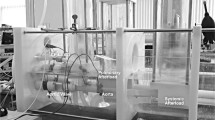Abstract
A pulsatile pump driven by a coil spring, which was designed and constructed by us, is described in this report. It consists of two main parts, a disposable blood chamber and a driving section. The blood chamber has two leaflet valves and a piston, which is covered with two bellofram rolling diaphragms and moves into the housing to draw in and eject the blood. The driving section consists of three cams, an electric motor and a coil spring. The ejection force is wholly produced by the compressed coil spring and is transmitted to the piston in the blood chamber by a rod. This pump allows the ejection pressure, the beat rates, and the stroke volume all to be changed independently. The performance of the pump was tested by using a circulation model where the beat rate was adjusted from 30 to 250 bpm. The output subsequently increased from 0.81/min to 5.71/min and the stroke volume, from 20.4 ml to 36.7 ml. This new pump has been used for clinical cardiopulmonary bypasses in 24 patients of open heart surgery and the pressure traces during perfusion resembled those of the patients’ own hearts.
Similar content being viewed by others
References
Sasaki Y. Perfusion cooling by pulsatile flow. Jpn J Surg 1977; 7: 81–89.
Taylor KM. Pulsatile cardiopulmonary bypass, a review. J Cardiovasc Surg 1981; 22: 561–568.
Philbin DM, Levine FH, Kono K, Coggins CH, Moss J, Slater EE, Buckley MJ. Attention of the stress response to cardiopulmonary bypass by the addition of pulsatile flow. Circulation 1981; 64: 808–812.
Levine FH, Philbin DM, Kono K, Coggins CH, Emerson CW, Austen WG, Buckley MJ. Plasma vasopressin levels and urinary sodium excretion during cardio-pulmonary bypass with and without pulsatile flow. Ann Thorac Surg 1981; 32: 63–67.
Watkins WD, Peterson MB, Kong DL, Kono K, Buckley MJ, Levine FH, Philbin DM. Thromboxane and prostacyclin changes during cardiopulmonary bypass with and without pulsatile flow. J Thorac Cardiovasc Surg 1982; 22: 561–568.
Taylor KM, Bain WH, Davidson KG, Turner MA. Comparative clinical study of pulsatile and nonpulsatile perfusion in 350 consecutive patients. Thorax 1982; 37: 324–330.
Faraci PA, Davis JP, Daly BDT, Cleveland RJ. The effect of pulsatile cardiopulmonary bypass on limbs, blood flow and tissue perfusion. Trans Am Soc Artif Intern Organs 1983; 35: 488–492.
Nieminen MT, Philbin DM, Rosaw CE, Lowenstein E, Triantafillon A, Levine FH, Buckley MJ. Temperature gradients and rewarming time during hypothermic cardiopulmonary bypass with and without pulsatile flow. Ann Thorac Surg 1983; 35: 488–492.
Chiu I, Chu S, Hung C. Pulsatile flow during routine cardiopulmonary bypass. J Cardiovasc Surg 1984; 25: 530–536.
Lindberg H, Svennevig JL, Lilleaasen P, Vatne K. Pulsatile vs. nonpulsatile flow during cardiopulmonary bypass, a comparison of early postoperative changes. Scand J Thorac Cardiovasc Surg 1984; 18: 195–201.
Waaben J, Andersen K, Husum B. Pulsatile flow during cardiopulmonary bypass. Scand J Thorac Cardiovasc Surg 1985; 19: 149–153.
Grossi EA, Connolly MW, Krieger KH, Nathan IM, Hunter CE, Colvin SB, Baumann FG, Spencer FC. Quantification of pulsatile flow during cardiopulmonary bypass to permit direct comparison of the effectiveness of various types of “pulsatile” and “nonpulsatile” flow. Surgery 1985; 98: 547–554.
Belcher P, Lennox SC. The effect of low flow, low pressure pulsatile bypass. J Cardiovasc Surg 1985; 26: 223–227.
Sasaki Y, Sakabe H, Hara T, Hashimoto I. A small pulsatile pump for extra-corporeal circulation. Jpn J Surg 1977; 7: 90–95.
Sakabe H, Sasaki Y, Wada Y, Ochi S, Shimada H, Sato S, Naito K, Tamari K, Shirakata S, Nakamura A, Oga K, Nakaji S, Hara T, Hashimoto I. A middle sized pulsatile pump for cardiopulmonary bypass. Artif Organs 1979; 8: 723–726. (in Japanese)
Wada Y, Sasaki Y, Kadowaki M, Kitaura K, Nishiyama K, Murayama Y, Hashimoto T, Shirakata S, Oga K, Oka T. Clinical studies on pulsatile perfusion cooling for open heart surgery. J Jpn Thorac Surg 1986; 34: 213–219.
Author information
Authors and Affiliations
Rights and permissions
About this article
Cite this article
Sasaki, Y., Kawai, T., Nishiyama, K. et al. A pulsatile pump for cardiopulmonary bypass and its clinical use. The Japanese Journal of Surgery 18, 487–493 (1988). https://doi.org/10.1007/BF02471480
Received:
Issue Date:
DOI: https://doi.org/10.1007/BF02471480



